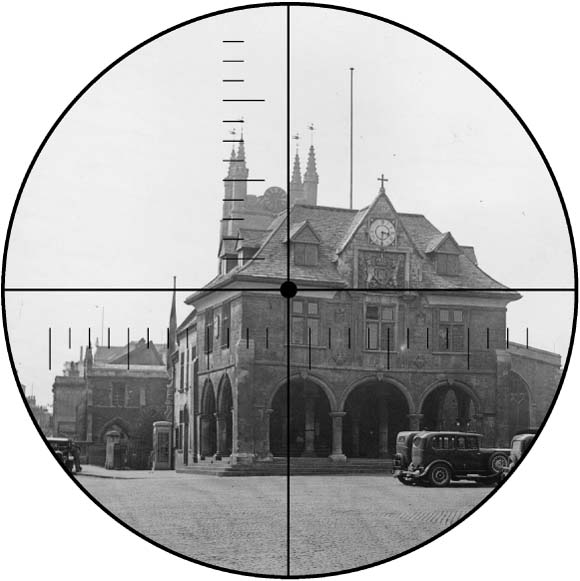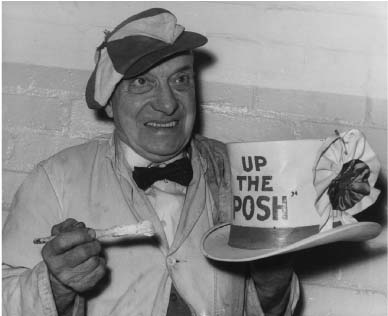Lyttelton's Britain (19 page)
Read Lyttelton's Britain Online
Authors: Iain Pattinson

Peterborough Town Hall, 1940. (Photo by kind permission of the German Navy)

P
ETERBOROUGH
is fine cathedral city boasting a long and fascinating history. There is evidence of a Bronze Age settlement at ‘Flag Fen’ to the east of the city. This fenland site was discovered in 1982 when a team funded by English Heritage carried out a survey of local dykes. And when they couldn’t help, the team started digging up old flood defences.
Despite the fact that they were mainly marshland, the fens were first inhabited around 35,000 years ago, the earliest settlers having walked from Europe, which was then still attached to England. Evidence exists of many from France occupying the local bogs, as they were so much nicer than the French ones.
Peterborough’s cathedral has its origins in the Saxon abbey built in the 10th Century and dedicated to St Peter. As it expanded, the abbey and its surroundings were known as a ‘burgh’, which soon came to be called St Peter’s Burgh. Eventually of course that name evolved into the one we know today: Leningrad.
Following the invasion of William the Conqueror, the Peterborough area was the last in England to submit to Norman rule. This was due to rebellions in the Fens led by the resistance fighter, Hereward the Wake, the first man in England to own an alarm clock.
It’s officially recorded that Peterborough Town Hall is exactly 75 miles from London’s Charing Cross. The cross was commissioned
by King Edward I in memory of Eleanor, his queen. Such was the depth of his grief at the death of his beautiful bride, Edward decreed that a cross be carved ornately in marble from the Dolomites, inlaid with gold and lapis lazuli, and be erected exactly 75 miles from Peterborough Town Hall.
Catherine of Aragon came to live near Peterborough after her divorce from Henry VIII. Her settlement included estates at Kimbolton Castle, an annual pension of a thousand gold ducats, a fondue set and half a canteen of cutlery. She also got Aquitaine, but had to give it back every other weekend.
Burghley House, built by William Cecil in 1572 at Peterborough Soke, has since 1961 been home to the Burghley Horse Trials. The absolute pinnacle of equestrian eventing, spectators flock there annually from across the country in the hope of seeing a posh bird fall into a muddy pond.
Although now officially part of Cambridgeshire, Peterborough has at various times been in Rutland, Northamptonshire and Lincolnshire. One resident aged 98 who has lived in the same cottage all his life has recently been hospitalised with chronic travel sickness.
This part of England is notoriously flat and low-lying, with many areas actually below sea level. This was never a problem until the German raids of 1940, when the town hall was torpedoed by a U-Boat.
During the war, radar was invented at nearby RAF Wittering, and to celebrate the anniversary of the event, the original machinery was recently restored to re-enact its first use. At 8.30 am on the 10th October 2001, a team of technicians set the equipment running, while at the same time a restored World War
II German bomber set off from Hamburg. And, sure enough, at just after 9.15, France surrendered.
The automotive engineer Henry Royce was born in Peterborough. He formed a company with Charles Rolls, to build the finest cars in the world. It was their boast that, having turned the ignition key, you would never hear the engine running. I had an Austin Metro like that.
Just a few miles to the north of Peterborough is the town of Grantham – the birthplace of both Margaret Thatcher and Nicholas Parsons. That such a small town should produce even one great talent of world renown and adoration would be remarkable, but to produce two, well that didn’t happen either.
Also born near Peterborough was Douglas Metcalfe, the pioneer of the modern home computer. Sadly, Metcalfe died in hospital in 1968, following a minor malfunction of his life support machine. His last words were: ‘Have you tried switching it off and on again?’

David Beckham’s Relate counsellor

C
AMBRIDGE
is the university city that has a special place in the hearts of many, as it was there that Tim Brooke-Taylor and Graeme Garden were discovered when they were undergraduates. Luckily they slipped away in the confusion of the police raid and no charges were ever brought.
And Barry Cryer was once offered a chair there. What a nice old lady.
Other great historical Cambridge names include Sir Isaac Newton, who was Professor of Gravitational Physics at Trinity, where he also taught a little Greek, who went on to open Cambridge’s premier kebab shop.
At nearby Grantchester lives the novelist, jailbird and stock market Mystic Meg, Jeffrey Archer. Archer upholds that fine tradition of English writing that can be traced in a direct line from Webster’s dramatic quill, through Swift’s satirical pen, right down to his own overworked photocopier.

T
HIS HISTORIC
Suffolk town is swelled to overflowing during the annual carnival, when thousands of gailyclad, olive-skinned dancers Samba through the streets to the incessant rhythmic beat of the bongo. Towards dawn, the heaving throng form into a torch-lit procession which wends its way up nearby Sugar Loaf Mountain to watch the sun rise over Copacabana Beach, their huge feathered headdresses swaying in the warm tropical breeze as they chant and sing their welcome to the new dawn. These are just a few of the rich pleasures which make this town, unmistakably, Bury St Edmunds. Or is that Rio de Janeiro?
Bury St Edmunds also became famous recently following a promotional campaign run by the Suffolk Tourist Board. There was mass rioting in the streets when, thanks to an unfortunate printing error, thousands of posters were issued encouraging one and all to ‘VISIT SUFFOLK AND BURY NOEL EDMONDS’. One can only imagine their disappointment.

T
HE FINE COUNTY TOWN
of Ipswich is the undisputed jewel in Suffolk’s crown. A beautiful county of gently rolling hills, Suffolk is bordered by Norfolk (with its historic Tudor villages and nature reserve coastline), by Cambridgeshire (with its fine university and unspoilt country-side) and by Essex.
The name ‘Suffolk’ is actually a corruption of ‘South Folk’, as the area was known until the 13th Century. It was in 1215 that King John was confronted in Ipswich by the barons before he was taken to Runnymede to sign Magna Carta. King John was of course completely illiterate: on being instructed to sign with a cross, he solemnly drew a circle. His mark was countersigned by the Bailiff of Ipswich, who inscribed the initials of ‘John Reginum’ alongside his area of responsibility. And thus Magna Carta was duly annotated: ‘JR, South Folk’.
Magna Carta established the principle of ‘Habeas Corpus’ that still applies to this day – a law stating that no man in England may be imprisoned indefinitely without fair trial before judge and jury, unless of course he appears a bit foreign-looking.
Thanks to sea trade with Europe, Ipswich flourished during the Middle Ages, having close ties with the town of Antwerp, twinned with Dectwerp.
During the First World War, the pork processing plant was
requisitioned to produce ammunition. Small explosive devices similar to Mills Grenades were made there and became nicknamed ‘Sausage Bombs’, but without careful storage they kept going off.
In 1903 the world’s first ever lawnmower was invented here, and in 1986 it was lent to the Science Museum. Ipswich still hasn’t got it back.
Just along the coast is the village of Orford, famous for its ancient smoke house where herrings, salmon and eels are cured. The owner recently experimented with many different types of wood to produce a variety of smokes, with the result that the nuns at nearby Orford Convent celebrated seven new Popes in one afternoon.
By Victorian times, Ipswich was growing rapidly and horse drawn trams were introduced. However, with the construction of a power station in 1888, these old, slow conveyances were adapted to run on electricity. It was amazing how they speeded up when the horses had 240 volts put through them.
The Victorians constructed many fine buildings, including Ipswich County Hall. This houses the court where Mrs Wallis Simpson obtained her divorce prior to marrying the Duke of Windsor. However, Wallis kept her married surname, preferring not to go back to her maiden name of ‘And-Gromit’.